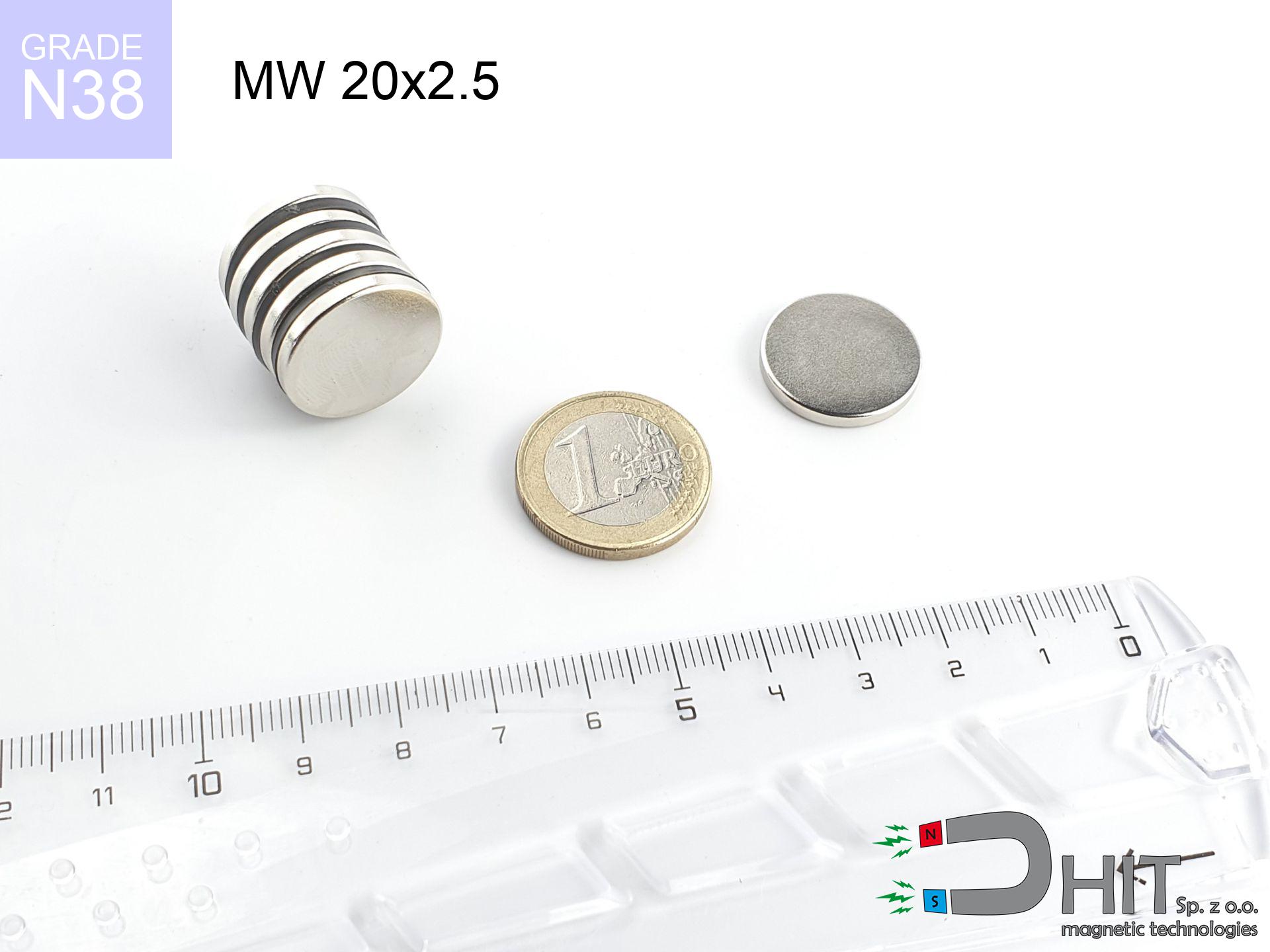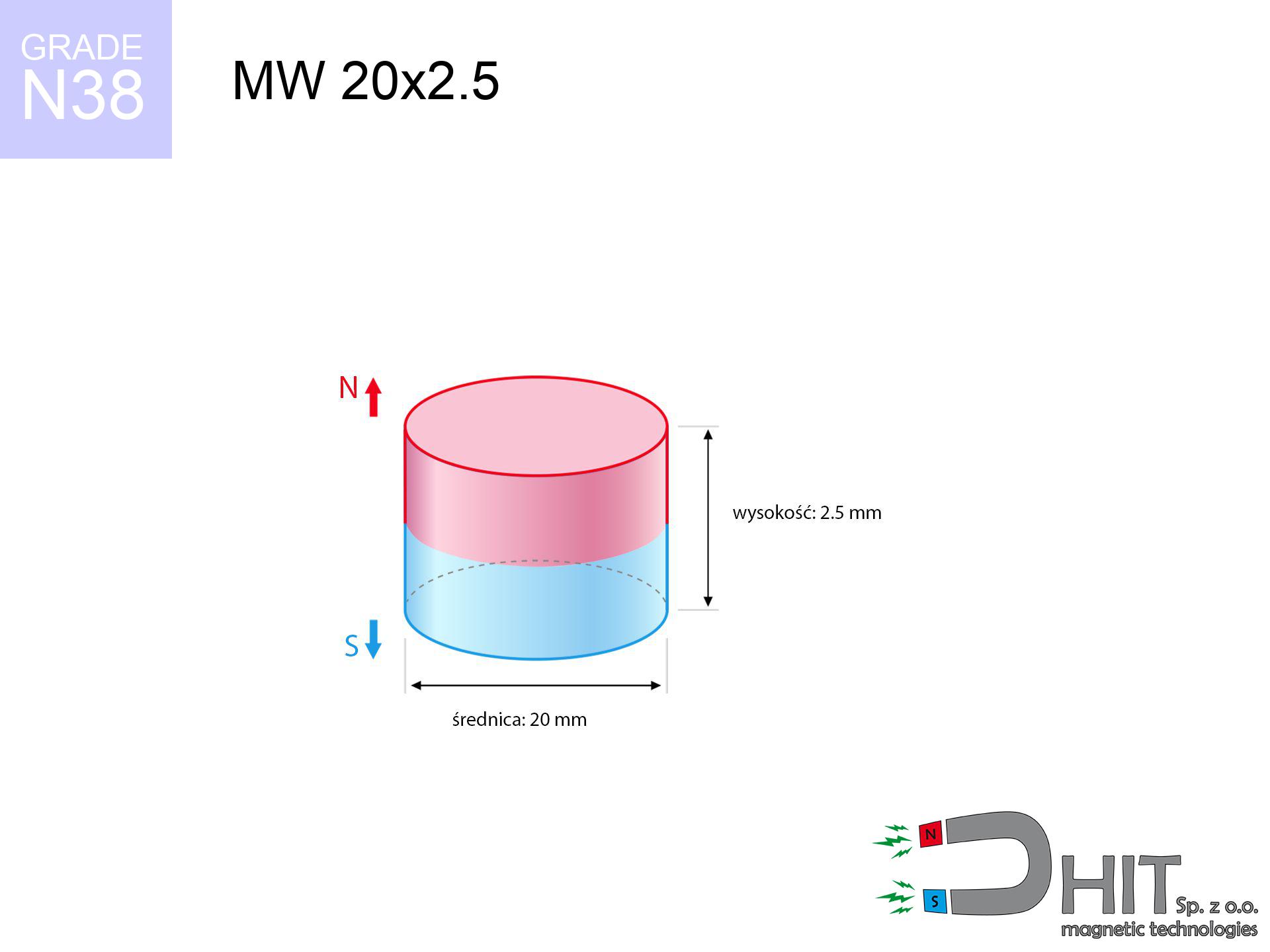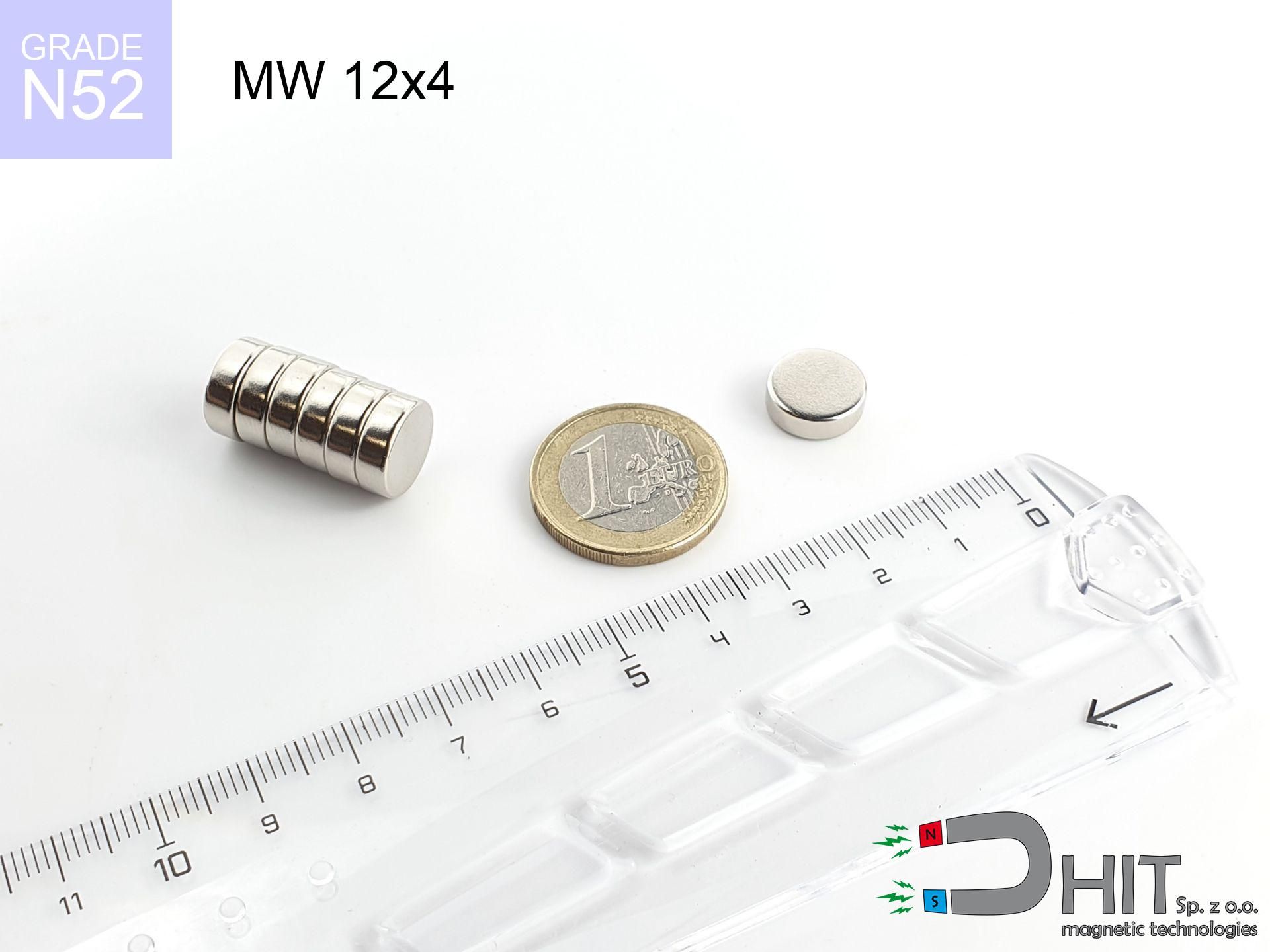MW 20x2.5 / N38 - cylindrical magnet
cylindrical magnet
Catalog no 010042
GTIN: 5906301810414
Diameter Ø
20 mm [±0,1 mm]
Height
2.5 mm [±0,1 mm]
Weight
5.89 g
Magnetization Direction
↑ axial
Load capacity
1.95 kg / 19.09 N
Magnetic Induction
150.34 mT
Coating
[NiCuNi] Nickel
2.51 ZŁ with VAT / pcs + price for transport
2.04 ZŁ net + 23% VAT / pcs
bulk discounts:
Need more?Need advice?
Pick up the phone and ask
+48 22 499 98 98
otherwise drop us a message by means of
request form
the contact form page.
Parameters along with shape of magnetic components can be tested with our
magnetic calculator.
Same-day shipping for orders placed before 14:00.
MW 20x2.5 / N38 - cylindrical magnet
Specification / characteristics MW 20x2.5 / N38 - cylindrical magnet
| properties | values |
|---|---|
| Cat. no. | 010042 |
| GTIN | 5906301810414 |
| Production/Distribution | Dhit sp. z o.o. |
| Country of origin | Poland / China / Germany |
| Customs code | 85059029 |
| Diameter Ø | 20 mm [±0,1 mm] |
| Height | 2.5 mm [±0,1 mm] |
| Weight | 5.89 g |
| Magnetization Direction | ↑ axial |
| Load capacity ~ ? | 1.95 kg / 19.09 N |
| Magnetic Induction ~ ? | 150.34 mT |
| Coating | [NiCuNi] Nickel |
| Manufacturing Tolerance | ±0.1 mm |
Magnetic properties of material N38
| properties | values | units |
|---|---|---|
| remenance Br [Min. - Max.] ? | 12.2-12.6 | kGs |
| remenance Br [Min. - Max.] ? | 1220-1260 | T |
| coercivity bHc ? | 10.8-11.5 | kOe |
| coercivity bHc ? | 860-915 | kA/m |
| actual internal force iHc | ≥ 12 | kOe |
| actual internal force iHc | ≥ 955 | kA/m |
| energy density [Min. - Max.] ? | 36-38 | BH max MGOe |
| energy density [Min. - Max.] ? | 287-303 | BH max KJ/m |
| max. temperature ? | ≤ 80 | °C |
Physical properties of sintered neodymium magnets Nd2Fe14B at 20°C
| properties | values | units |
|---|---|---|
| Vickers hardness | ≥550 | Hv |
| Density | ≥7.4 | g/cm3 |
| Curie Temperature TC | 312 - 380 | °C |
| Curie Temperature TF | 593 - 716 | °F |
| Specific resistance | 150 | μΩ⋅Cm |
| Bending strength | 250 | Mpa |
| Compressive strength | 1000~1100 | Mpa |
| Thermal expansion parallel (∥) to orientation (M) | (3-4) x 106 | °C-1 |
| Thermal expansion perpendicular (⊥) to orientation (M) | -(1-3) x 10-6 | °C-1 |
| Young's modulus | 1.7 x 104 | kg/mm² |
Technical modeling of the magnet - report
The following data are the outcome of a mathematical calculation. Values were calculated on algorithms for the class NdFeB. Operational parameters may differ. Please consider these calculations as a reference point during assembly planning.
MW 20x2.5 / N38
| Distance (mm) | Induction (Gauss) / mT | Pull Force (kg) | Risk Status |
|---|---|---|---|
| 0 mm |
1503 Gs
150.3 mT
|
1.95 kg / 1950.0 g
19.1 N
|
weak grip |
| 1 mm |
1431 Gs
143.1 mT
|
1.77 kg / 1767.8 g
17.3 N
|
weak grip |
| 2 mm |
1328 Gs
132.8 mT
|
1.52 kg / 1522.8 g
14.9 N
|
weak grip |
| 5 mm |
947 Gs
94.7 mT
|
0.77 kg / 774.4 g
7.6 N
|
weak grip |
| 10 mm |
457 Gs
45.7 mT
|
0.18 kg / 180.5 g
1.8 N
|
weak grip |
| 15 mm |
224 Gs
22.4 mT
|
0.04 kg / 43.5 g
0.4 N
|
weak grip |
| 20 mm |
120 Gs
12.0 mT
|
0.01 kg / 12.5 g
0.1 N
|
weak grip |
| 30 mm |
44 Gs
4.4 mT
|
0.00 kg / 1.7 g
0.0 N
|
weak grip |
| 50 mm |
11 Gs
1.1 mT
|
0.00 kg / 0.1 g
0.0 N
|
weak grip |
MW 20x2.5 / N38
| Surface type | Friction coefficient / % Mocy | Max load (kg) |
|---|---|---|
| Raw steel |
µ = 0.3
30% Nominalnej Siły
|
0.59 kg / 585.0 g
5.7 N
|
| Painted steel (standard) |
µ = 0.2
20% Nominalnej Siły
|
0.39 kg / 390.0 g
3.8 N
|
| Oily/slippery steel |
µ = 0.1
10% Nominalnej Siły
|
0.20 kg / 195.0 g
1.9 N
|
| Magnet with anti-slip rubber |
µ = 0.5
50% Nominalnej Siły
|
0.98 kg / 975.0 g
9.6 N
|
MW 20x2.5 / N38
| Steel thickness (mm) | % power | Real pull force (kg) |
|---|---|---|
| 0.5 mm |
|
0.20 kg / 195.0 g
1.9 N
|
| 1 mm |
|
0.49 kg / 487.5 g
4.8 N
|
| 2 mm |
|
0.98 kg / 975.0 g
9.6 N
|
| 5 mm |
|
1.95 kg / 1950.0 g
19.1 N
|
| 10 mm |
|
1.95 kg / 1950.0 g
19.1 N
|
MW 20x2.5 / N38
| Ambient temp. (°C) | Power loss | Remaining pull | Status |
|---|---|---|---|
| 20 °C | 0.0% |
1.95 kg / 1950.0 g
19.1 N
|
OK |
| 40 °C | -2.2% |
1.91 kg / 1907.1 g
18.7 N
|
OK |
| 60 °C | -4.4% |
1.86 kg / 1864.2 g
18.3 N
|
OK |
| 80 °C | -6.6% |
1.82 kg / 1821.3 g
17.9 N
|
|
| 100 °C | -28.8% |
1.39 kg / 1388.4 g
13.6 N
|
MW 20x2.5 / N38
| Gap (mm) | Attraction (kg) (N-S) | Repulsion (kg) (N-N) |
|---|---|---|
| 0 mm |
2.93 kg / 2925.0 g
28.7 N
|
N/A |
| 2 mm |
2.28 kg / 2280.0 g
22.4 N
|
2.13 kg / 2128.0 g
20.9 N
|
| 5 mm |
1.16 kg / 1155.0 g
11.3 N
|
1.08 kg / 1078.0 g
10.6 N
|
| 10 mm |
0.27 kg / 270.0 g
2.6 N
|
0.25 kg / 252.0 g
2.5 N
|
| 20 mm |
0.02 kg / 15.0 g
0.1 N
|
0.01 kg / 14.0 g
0.1 N
|
| 50 mm |
0.00 kg / 0.0 g
0.0 N
|
0.00 kg / 0.0 g
0.0 N
|
MW 20x2.5 / N38
| Object / Device | Limit (Gauss) / mT | Safe distance |
|---|---|---|
| Pacemaker | 5 Gs (0.5 mT) | 7.0 cm |
| Hearing aid | 10 Gs (1.0 mT) | 5.5 cm |
| Timepiece | 20 Gs (2.0 mT) | 4.5 cm |
| Mobile device | 40 Gs (4.0 mT) | 3.5 cm |
| Car key | 50 Gs (5.0 mT) | 3.0 cm |
| Payment card | 400 Gs (40.0 mT) | 1.5 cm |
| HDD hard drive | 600 Gs (60.0 mT) | 1.0 cm |
MW 20x2.5 / N38
| Start from (mm) | Speed (km/h) | Energy (J) | Predicted outcome |
|---|---|---|---|
| 10 mm |
19.38 km/h
(5.38 m/s)
|
0.09 J | |
| 30 mm |
31.80 km/h
(8.83 m/s)
|
0.23 J | |
| 50 mm |
41.03 km/h
(11.40 m/s)
|
0.38 J | |
| 100 mm |
58.03 km/h
(16.12 m/s)
|
0.77 J |
MW 20x2.5 / N38
| Technical parameter | Value / Description |
|---|---|
| Coating type | [NiCuNi] Nickel |
| Layer structure | Nickel - Copper - Nickel |
| Layer thickness | 10-20 µm |
| Salt spray test (SST) ? | 24 h |
| Recommended environment | Indoors only (dry) |
MW 20x2.5 / N38
| Environment | Effective steel pull | Effect |
|---|---|---|
| Air (land) | 1.95 kg | Standard |
| Water (riverbed) |
2.23 kg
(+0.28 kg Buoyancy gain)
|
+14.5% |
Other products
Strengths as well as weaknesses of NdFeB magnets.
Apart from their strong magnetic energy, neodymium magnets have these key benefits:
- Their magnetic field remains stable, and after around ten years it decreases only by ~1% (according to research),
- Magnets effectively protect themselves against loss of magnetization caused by external fields,
- The use of an elegant finish of noble metals (nickel, gold, silver) causes the element to present itself better,
- Neodymium magnets deliver maximum magnetic induction on a small area, which increases force concentration,
- Made from properly selected components, these magnets show impressive resistance to high heat, enabling them to function (depending on their form) at temperatures up to 230°C and above...
- Possibility of detailed forming and optimizing to specific conditions,
- Fundamental importance in innovative solutions – they serve a role in magnetic memories, electric drive systems, diagnostic systems, also other advanced devices.
- Relatively small size with high pulling force – neodymium magnets offer strong magnetic field in small dimensions, which makes them useful in miniature devices
Problematic aspects of neodymium magnets: tips and applications.
- To avoid cracks upon strong impacts, we suggest using special steel housings. Such a solution protects the magnet and simultaneously increases its durability.
- NdFeB magnets demagnetize when exposed to high temperatures. After reaching 80°C, many of them experience permanent weakening of strength (a factor is the shape as well as dimensions of the magnet). We offer magnets specially adapted to work at temperatures up to 230°C marked [AH], which are extremely resistant to heat
- Magnets exposed to a humid environment can rust. Therefore while using outdoors, we suggest using water-impermeable magnets made of rubber, plastic or other material resistant to moisture
- We suggest cover - magnetic mount, due to difficulties in realizing threads inside the magnet and complex forms.
- Potential hazard resulting from small fragments of magnets can be dangerous, when accidentally swallowed, which becomes key in the context of child safety. Furthermore, small elements of these magnets can disrupt the diagnostic process medical after entering the body.
- High unit price – neodymium magnets are more expensive than other types of magnets (e.g. ferrite), which hinders application in large quantities
Highest magnetic holding force – what contributes to it?
Magnet power was determined for optimal configuration, including:
- on a base made of mild steel, optimally conducting the magnetic flux
- whose transverse dimension equals approx. 10 mm
- characterized by even structure
- with direct contact (no coatings)
- under axial application of breakaway force (90-degree angle)
- at room temperature
Lifting capacity in practice – influencing factors
During everyday use, the actual lifting capacity is determined by several key aspects, ranked from crucial:
- Distance – existence of any layer (paint, dirt, gap) interrupts the magnetic circuit, which reduces capacity rapidly (even by 50% at 0.5 mm).
- Angle of force application – highest force is reached only during perpendicular pulling. The resistance to sliding of the magnet along the plate is standardly many times lower (approx. 1/5 of the lifting capacity).
- Substrate thickness – for full efficiency, the steel must be adequately massive. Thin sheet restricts the attraction force (the magnet "punches through" it).
- Chemical composition of the base – low-carbon steel gives the best results. Higher carbon content lower magnetic properties and lifting capacity.
- Surface structure – the more even the surface, the better the adhesion and stronger the hold. Unevenness acts like micro-gaps.
- Temperature – temperature increase results in weakening of force. Check the thermal limit for a given model.
* Lifting capacity testing was conducted on plates with a smooth surface of suitable thickness, under a perpendicular pulling force, in contrast under shearing force the load capacity is reduced by as much as 75%. Additionally, even a minimal clearance {between} the magnet’s surface and the plate decreases the lifting capacity.
Safe handling of neodymium magnets
Conscious usage
Handle magnets consciously. Their huge power can surprise even professionals. Be vigilant and do not underestimate their power.
Magnets are brittle
Watch out for shards. Magnets can fracture upon violent connection, ejecting sharp fragments into the air. Eye protection is mandatory.
Physical harm
Large magnets can smash fingers in a fraction of a second. Never place your hand betwixt two attracting surfaces.
Magnetic interference
An intense magnetic field interferes with the operation of magnetometers in phones and navigation systems. Keep magnets close to a smartphone to prevent damaging the sensors.
Electronic hazard
Equipment safety: Neodymium magnets can ruin payment cards and delicate electronics (pacemakers, medical aids, timepieces).
Heat warning
Regular neodymium magnets (grade N) lose magnetization when the temperature goes above 80°C. The loss of strength is permanent.
Fire risk
Machining of NdFeB material carries a risk of fire hazard. Neodymium dust oxidizes rapidly with oxygen and is difficult to extinguish.
Product not for children
Neodymium magnets are not toys. Eating several magnets may result in them attracting across intestines, which poses a severe health hazard and requires urgent medical intervention.
Metal Allergy
Allergy Notice: The nickel-copper-nickel coating consists of nickel. If redness happens, cease handling magnets and wear gloves.
Life threat
Warning for patients: Powerful magnets affect electronics. Maintain minimum 30 cm distance or ask another person to handle the magnets.
Caution!
More info about hazards in the article: Magnet Safety Guide.







![UMP 75x25 [M10x3] GW F200 PLATINIUM / N52 - search holder UMP 75x25 [M10x3] GW F200 PLATINIUM / N52 - search holder](https://cdn3.dhit.pl/graphics/products/ump-75x25-m10x3-gw-f200-platinium-tav.jpg)

